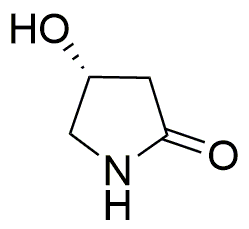(R)-(+)-4-Hydroxy-2-pyrrolidinone is widely utilized in research focused on:
- Pharmaceutical Development: This compound serves as a key intermediate in the synthesis of various pharmaceuticals, particularly in the development of drugs targeting neurological disorders.
- Chiral Building Blocks: It is an important chiral building block in organic synthesis, allowing chemists to create enantiomerically pure compounds, which are crucial for the efficacy of many drugs.
- Biochemical Research: Researchers use this compound to study its effects on biological systems, helping to understand metabolic pathways and enzyme interactions.
- Polymer Chemistry: It can be utilized in the formulation of biodegradable polymers, contributing to environmentally friendly materials that are gaining traction in various industries.
- Cosmetic Applications: The compound is also explored for its potential in cosmetic formulations, where it may enhance skin hydration and stability of products.
General Information
Properties
Safety and Regulations
Applications
(R)-(+)-4-Hydroxy-2-pyrrolidinone is widely utilized in research focused on:
- Pharmaceutical Development: This compound serves as a key intermediate in the synthesis of various pharmaceuticals, particularly in the development of drugs targeting neurological disorders.
- Chiral Building Blocks: It is an important chiral building block in organic synthesis, allowing chemists to create enantiomerically pure compounds, which are crucial for the efficacy of many drugs.
- Biochemical Research: Researchers use this compound to study its effects on biological systems, helping to understand metabolic pathways and enzyme interactions.
- Polymer Chemistry: It can be utilized in the formulation of biodegradable polymers, contributing to environmentally friendly materials that are gaining traction in various industries.
- Cosmetic Applications: The compound is also explored for its potential in cosmetic formulations, where it may enhance skin hydration and stability of products.
Documents
Safety Data Sheets (SDS)
The SDS provides comprehensive safety information on handling, storage, and disposal of the product.
Product Specification (PS)
The PS provides a comprehensive breakdown of the product’s properties, including chemical composition, physical state, purity, and storage requirements. It also details acceptable quality ranges and the product's intended applications.
Certificates of Analysis (COA)
Search for Certificates of Analysis (COA) by entering the products Lot Number. Lot and Batch Numbers can be found on a product’s label following the words ‘Lot’ or ‘Batch’.
*Catalog Number
*Lot Number
Certificates Of Origin (COO)
This COO confirms the country where the product was manufactured, and also details the materials and components used in it and whether it is derived from natural, synthetic, or other specific sources. This certificate may be required for customs, trade, and regulatory compliance.
*Catalog Number
*Lot Number
Safety Data Sheets (SDS)
The SDS provides comprehensive safety information on handling, storage, and disposal of the product.
DownloadProduct Specification (PS)
The PS provides a comprehensive breakdown of the product’s properties, including chemical composition, physical state, purity, and storage requirements. It also details acceptable quality ranges and the product's intended applications.
DownloadCertificates of Analysis (COA)
Search for Certificates of Analysis (COA) by entering the products Lot Number. Lot and Batch Numbers can be found on a product’s label following the words ‘Lot’ or ‘Batch’.
*Catalog Number
*Lot Number
Certificates Of Origin (COO)
This COO confirms the country where the product was manufactured, and also details the materials and components used in it and whether it is derived from natural, synthetic, or other specific sources. This certificate may be required for customs, trade, and regulatory compliance.


